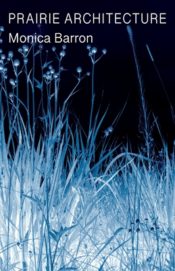 Monica Barron
Monica Barron
Golden Antelope Press ($15.95)
by Andy Harper
The first collection from a seasoned poet of place, Monica Barron’s Prairie Architecture is particularly good pandemic reading. To write the rural Missouri college town where Barron is a professor of English and to live in the era of distancing both call for the patterns of observation ingrained in the form and voice of these poems.
A distanced intimacy unites the collection, introduced by the speaker of the opening poem, who listens over coffee to
Gerry
in the screen-porch playing cello
to a cornfield yellowing fast . . .
. . . . . . . . . . . . . . . . . . . . . . . . .
the dogs covered in dust
that someone bellows for or maybe it’s to
out of anger that yellows his dried-up life.
Barron conjures the essayistic idler figure, listening from diners, fire pits, and hair salons, notebook at hand. This quiet intimacy resists the trite observation of small towns (that everyone knows everyone’s business), invoking instead an ethic of witness. Histories overheard in gas stations or at parties mobilize communal grieving, share warnings and fables of imperfect justice. In “Hunting Song,” the speaker muses,
If only the river had taken Audrey under
its mighty wing. She might never have shot
her husband in the kitchen after close.
The sign still says Audrey’s Place, but
how empty, how silent the place with her gone.
Barron makes of this roadside edifice an impromptu memorial, as she does elsewhere with a grain bin, an open field. In doing so, she acknowledges dual truths: that to belong to a place is to pass daily through these ghosts of history, and that their lessons are always contingent—legible more in hypotheticals than in certainties.
Prairie Architecture displays an appropriate nonchalance regarding structure, allowing us to slip with Barron into the comfort both of form and of a small Midwestern town without allowing repetition to stifle. Form remains loose, breaks down in improvisation, adaptation. “Meditation from West of the River” introduces a rule for repeated lines around stanza breaks—
Crossing the Mississippi late at night
I saw the ground fog rising to cover the road.I saw the ground fog rising to cover the road
give way to frost. Say what you want about love
—then allows that rule to become lax:
I want to help you live, to finally find
the synapse that connects the heart and mind.Whatever it is that connects the heart and mind
it’s at the mercy of memory.
Here again is Barron’s commitment to ambiguity. Here, too, and elsewhere, the author invites us into the process and prehistory of the poem. In some pieces, numbered segments mediate a range of historical and cognitive chronologies, charting how observation and meditation together mobilize meaning. Throughout, segmentation and circularity highlight patterns of life from small talk and travel to climate change and resource extraction.
This book is lucidly aware of its moment. In one of a handful of poems departing Kirksville for Barron’s annual trip to New Mexico, the speaker observes,
Before the border walls
there were mission walls.
At Tumacacori they crumbled
to Sonoran sand
and the fossilized pits
of Fr. Kino’s peaches.
Jesus replants the mission
orchard with the oldest
root stock he can find.
The double meaning that here collapses Christ with a farm worker plays throughout Prairie Architecture, but “Jesus in Three Movements” keenly renders the collection’s commitment to returning to our foundations—old walls of the past—to revive and reclaim an ethic of care with which to re-/build the psychic infrastructure our present moment demands. Near the end of the book, “Looking for Democrats in Novinger, MO” processes the 2016 election, offering gratitude to “older Black feminists” and Leonard Cohen, to old friends and “those younger who want our knowledge.”
Barron offers no blueprint for living through this pandemic; she not only tolerates but celebrates ambiguity and the constructed-ness of things. If these poems do offer any model, however, it is one for observing, for bearing witness, for gratitude and friendship. What we will do in these rural college towns is what we already do best: keep on caring for each other. This is the architecture of community and the politics of place.
